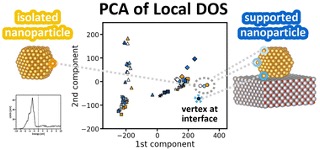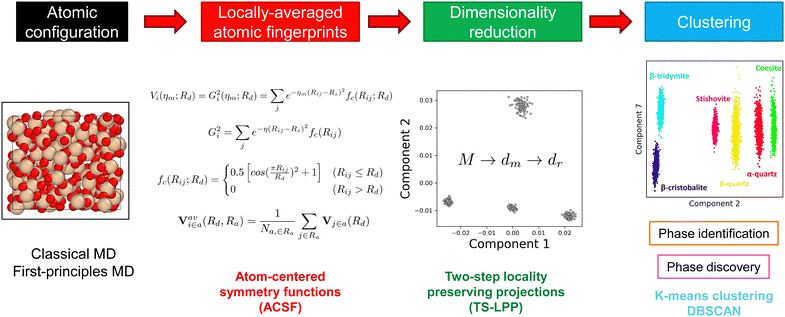Quantum Materials Field
Quantum Materials Simulation Group
We clarify the unique properties of complex quantum materials using state-of-the-art electronic structure calculations and machine-learning methods.
Group Leader: Tsuyoshi Miyazaki
Theoretical analysis of local atomic structures and electronic properties of complex materials using large-scale DFT and machine-learning methods
Current Topics
We demonstrated that our recently proposed technique based on dimensionality reduction is powerful to find subtle differences in the local structures of silica in various phases at finite temperatures. We also performed large-scale DFT calculations to investigate the size and site dependences of atomic and electronic structures in isolated and supported gold nanoparticles and analyzed the local density of states at each atomic site using principal component analyses (PCA).

Fig. 1. Large-scale DFT calculations of isolated and supported gold nanoparticles and analysis of local density of states at each atomic site using principal component analyses (PCA). (ref. 2)
Outline of Research
Complex systems consisting of multiple nanoparts often show unexpected properties and new functions. Using our large-scale DFT code CONQUEST, we theoretically study composite nanomaterials and complex interfaces. These calculations reveal atomic-scale structures and electronic properties. Machine learning methods are used to extract hidden structure–property relationships.

Fig. 2. Schematic explanation of our theoretical analyses of local structures of silica in various phases, using large-scale DFT and unsupervised learning methods. (ref. 1)
References
- A. K. A. Lu, J. Lin, Y. Futamura, T. Sakurai, R. Tamura, and T. Miyazaki, Phys. Chem. Chem. Phys. 26 , 11657 (2024). DOI: 10.1039/d3cp06298h
- S. Li, T. Miyazaki, and A. Nakata, Phys. Chem. Chem. Phys. 26 , 20251 (2024). DOI: 10.1039/d4cp01094a
Group members
-
 Tsuyoshi Miyazaki・Group Leader
Tsuyoshi Miyazaki・Group Leader -
 Ayako Nakata・Principal Researcher
Ayako Nakata・Principal Researcher -
 Jun Nara・Principal Researcher
Jun Nara・Principal Researcher
Activities
-
Feb. 7 2024
Links


